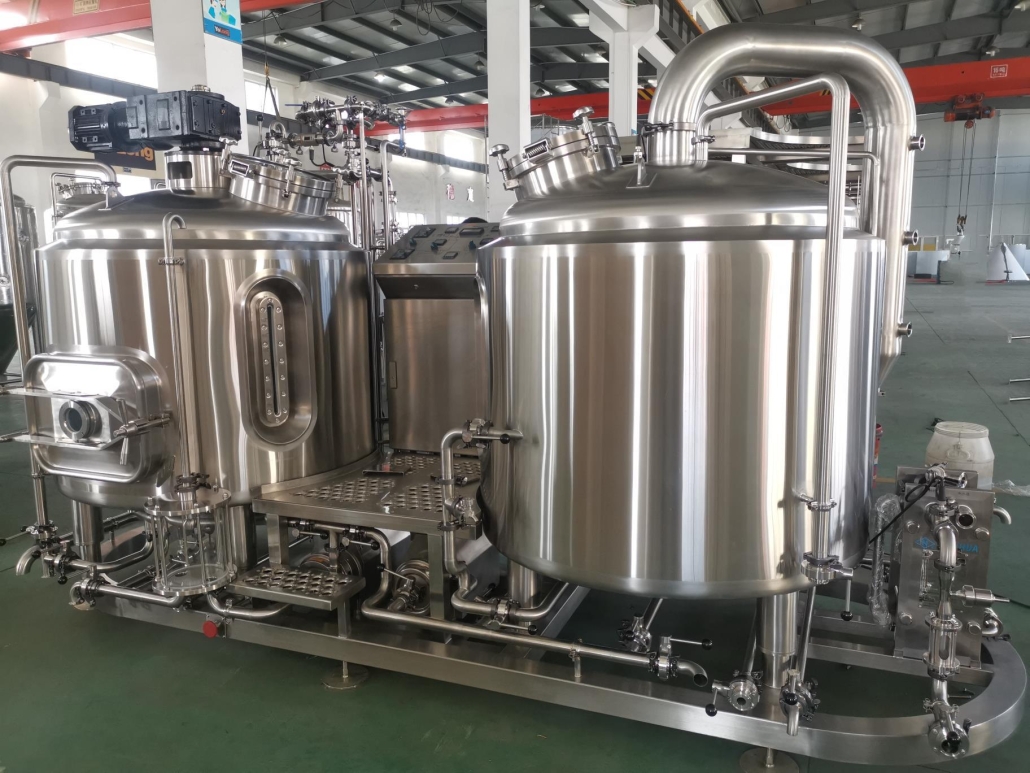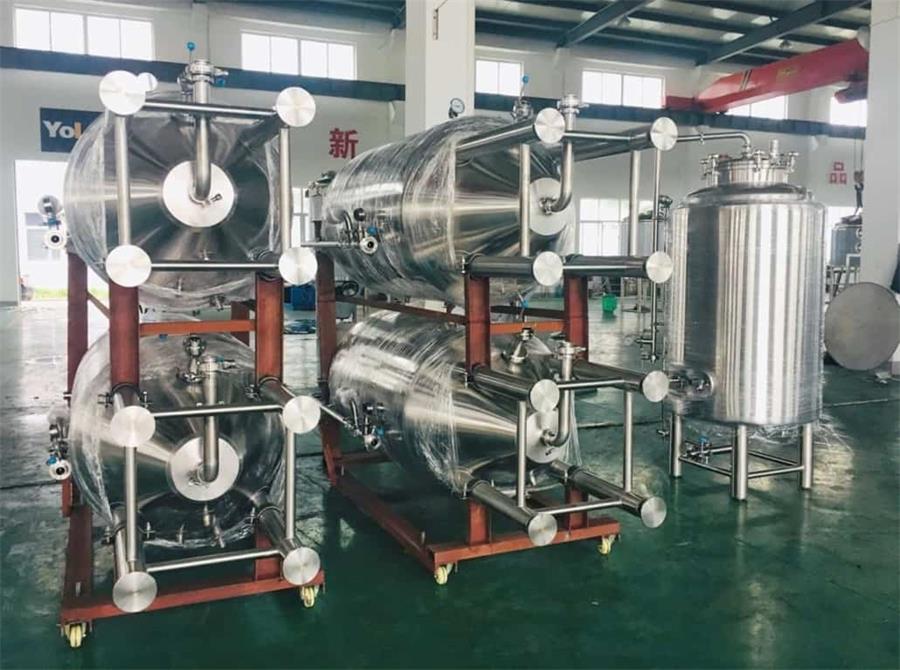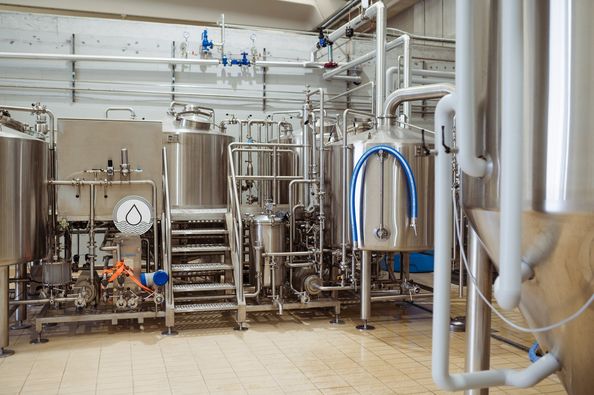3 BBL Hot Liquor Tank for Brewing
Hot liquor tanks are crucial components in commercial brewing systems, storing heated water for brewing use. This guide covers key considerations around 3 barrel (BBL) hot liquor tanks including types, sizing, customization, installation and maintenance recommendations to inform brewery buyers, operators and technicians.
3 BBL Hot Liquor Tank Overview
A hot liquor tank holds hot water which then mixes with grains in the mash tun during the brewing process. Key criteria for 3 BBL models include:
Temperature Maintenance – Maintain precise temperature control during mashing and sparging process stages
Constructed for Food Use – Made completely using food-grade stainless steel
Insulated – Limit heat loss to preserve energy and water temperatures
Integrated Sight Glass – Allow easy viewing of volume levels
CIP Compatible – Clean-in-place fittings and sprayballs enable automated cleaning
This guide provides extensive detail around available 3 BBL hot liquor tank options, customization possibilities, usage guidance and maintenance best practices for optimal brewery integration and performance.

Types of 3 BBL Hot Liquor Tanks
Hot liquor tanks for 3 BBL breweries are available in several configurations:
| Type | Description |
|---|---|
| Single Vessel | One insulated tank with heating element |
| Dual Vessel | Two tanks enable overlapping brews. More expensive. |
| Steam-Heated | External steam generator provides heat instead of element |
| Recirculating | Tank continually recirculates water to ensure uniformity |
Table 1: Primary types of hot liquor tanks for 3 BBL commercial brewing systems
Recirculating and steam-heated tanks prevent temperature gradients but add expense and complexity. Single vessel systems provide the most affordable setup for smaller breweries. Dual vessels allow brewing multiple batches simultaneously to increase production rates.
Sizing 3 BBL Hot Liquor Tanks
Properly sizing the hot liquor tank enables mashing in and sparging during the brewing process:
For a 3 BBL brewhouse producing 6-7 barrels per batch, recommended hot liquor tank volumes include:
- Single Vessel: 6 BBL capacity
- Dual Vessel: 3 BBL each
The extra capacity beyond the brewhouse accommodates:
- Mashing in – Mixing grains and hot liquor to form mash
- Sparging – Rinsing sugar from grains with hot liquor
- Temperature loss – Some cooling effect occurs in uninsulated vessels
An oversized tank prevents water shortage during crucial brewing steps. Slight extra room also enables limited expansion for special higher gravity beers.
Key Design Elements of 3 BBL Hot Liquor Tanks
Constructed entirely out of polished food-grade stainless steel, 3 BBL hot liquor tanks incorporate:
Vessel Construction – Formed heads allow easy cleaning. Dual tanks use cone bottom vessels.
Heating Elements – Steam heat exchanger or electric immersion heating element models available.
Insulation – Surrounding foam insulation minimizes temperature loss. Improves energy efficiency.
Sight Glass – Clear viewing window indicates volume level inside tank. Critical for monitoring.
Fittings – Clean-in-place sprayballs, sample valve, overflows, drains and temperature sensor fittings.
Controls – Automated digital controls for heating activation, temperature targets and pump operation if needed for recirculating varieties.
These commercial-grade vessels provide precise temperature control for consistent 3 BBL mashing and sparging.
Customizing 3 BBL Hot Liquor Tanks
While mainly standardized, some customization options for 3 BBL hot liquor tanks include:
- Heating Method – Electric immersion or external steam generator methods available
- Insulation Type – Polyurethane or mineral wool insulation materials
- Level Monitoring – Digital electronic sensors or basic sight glasses
- Recirculation – Addition of recirculation loop and pump
- Automation – Integrated digital process controller or independent modules
Evaluating options against brewhouse requirements and budget constraints allows custom-tailoring to the target brewing process. Single vessel tanks tend to be standardized while dual setups allow more customizable brewing.
Manufacturers of 3 BBL Hot Liquor Tanks
Many brewhouse equipment companies offer hot liquor tanks for 3 BBL commercial breweries. A partial list includes:
| Company | Tank Model | Price Range |
|---|---|---|
| JV Northwest | JV3-HLT | $8,500 – $12,000 |
| Ss Brewtech | 3 BBL InfuSsion Mash Tun | $7,899+ |
| Blichmann Engineering | 3 BBL Boil Kettle | $8,999+ |
| Premier Stainless | Custom 3 BBL HLT | Get Quote |
| Rocky Mountain Stainless | RMS3 HLT | Get Quote |
Table 2: 3 BBL hot liquor tank models and sample pricing from commercial brewhouse manufacturers
These and many other manufactures offer tailored HLT solutions. Get quotes based on required heating method, insulation, automation and other options selected.
Comparing Hot Liquor Tank Manufacturers
When selecting a 3 BBL hot liquor tank provider, key considerations include:
- Reputation – Well-reviewed companies indicate quality equipment and support
- Customization – Assess what types of customization are possible for tanks
- Quality – Require all stainless steel, food-grade constructions
- Validation – Look for CE/UL/3A sanitary certifications
- Cost – Get quotes from multiple vendors; validate quote details
- Support – Ensure after-sales support availability for future questions
- Delivery – Validate schedules and capabilities as lead times can be long
Taking time to thoroughly evaluate and compare hot liquor tank companies helps get equipment properly sized and configured for one’s brewhouse and budget.
3 BBL Hot Liquor Tank Pricing
Pricing depends on size, construction, heating methods and accessories:
- Base models – Start around $7,000-$9,000. Single vessel systems tend to be most economic.
- Customization – Special insulation, heating methods, automation etc. increase costs.
- Supporting infrastructure – External boilers, pumps and plumbing add expenses if needed.
- Bulk discounts – Larger multi-vessel or turnkey system quotes can reduce per-vessel costs.
Plan at least $8,000-15,000 for integrated 3 BBL hot liquor tank setups quoting all needed equipment and installation. Hot side brewhouse investments pay dividends through years of consistent mashing, efficiency and final beer quality.
Installing and Maintaining 3 BBL Hot Liquor Tanks
To sustain performance, 3 BBL hot liquor tanks require careful installation and scheduled upkeep:
Installation – Mount tanks securely level on floors or platforms. Connect all plumbing, heating lines and data cables needed. Test thoroughly.
Cleaning – Follow CIP protocols to clean entire vessel using automated cycles or manual scrubbing. Required after each brew day to prevent growth. Rinse extremely thoroughly as any residue can sour future brews.
Preventative Maintenance – Check sight glass, gaskets, insulation condition, safety relief valves and heating elements annually. Replace worn parts proactively.
Monitoring – Track temperatures and fluid levels during operation. Log for analysis. Detect deviations signaling potential issues.
Adhering to stringent cleaning, logging and maintenance routines maximizes 3 BBL hot liquor tank longevity while producing consistent quality brews.
| Task | Frequency | Description |
|---|---|---|
| CIP cleaning | After each brew | Thorough interior/exterior cleaning prevents contamination |
| Gasket inspection | 6 months | Replace worn gaskets causing air/fluid leaks |
| Heating element testing | Annually | Validate precise control to mash temperatures |
| Safety valve testing | Annually | Ensure valve opens if overpressurized |
| Insulation checks | Annually | Repair small holes or gaps reducing efficiency |
Table 3: Recommended preventative maintenance tasks and frequencies for 3 BBL hot liquor tanks
Staying on top of cleaning and scheduled upkeep enables 3 BBL hot liquor tanks to deliver the precise temperatures needed across years of flawless brewing. Both vessel and final beer quality depend heavily on a well-maintained hot side.
Comparing Single vs Dual Hot Liquor Tank Setups
When designing 3 BBL brewhouse infrastructure, brewers choose between single and dual vessel hot liquor tank configurations:
| Consideration | Single Tank | Dual Tank |
|---|---|---|
| Initial cost | Lower equipment expense | Higher capital cost |
| Temperature control | Potential gradients without recirculation | Uniformity easier to sustain |
| Brewing flexibility | Constrains brew timings | Allows overlapping brews |
| Maintenance needs | Simpler upkeep | Double vessels to maintain |
| Expansion potential | Limited for increased production | Additional vessels can add capacity |
Table 4: Tradeoffs between single and dual 3 BBL hot liquor tank configurations
For maximum flexibility enabling back-to-back brewing, dual tanks provide advantages. Single HLT setups however allow simpler operation and lower startup costs for new breweries.

FAQ
Q: What temperature is needed from a 3 BBL hot liquor tank?
A: Typical mash in temperature targets are 150-160°F. Sparge liquor around 170°F rinses sugars. Precise control is crucial.
Q: Can the hot liquor tank heat up liquid faster than brewers can use it?
A: Yes, even single vessels with electric heating elements can raise water temperature quite rapidly compared to mash tun flow rates.
Q: How often should hot liquor tanks be cleaned?
A: Thorough cleaning is required after every brew day. Even small amounts of residue can sour the mash. Rigorous protocols are a must.
Q: What safety considerations exist around hot liquor tanks?
A: Prevent burns by insulating pipes, using protective gear, and installing emergency pressure relief valves in case of heating element failures.
Q: Should recirculation be used in 3 BBL hot liquor tanks?
A: Recirculation helps larger tanks and steam heating achieve uniformity. For small electric element tanks, recirculation is generally not needed.
Frequently Asked Questions (FAQ)
1) What utility specs are recommended for a 3 BBL Hot Liquor Tank for Brewing?
- 208–480V 3‑phase power (region dependent) for electric elements or a low‑pressure steam supply for steam‑jacketed units; 0.5–1.0” NPT/tri‑clamp water inlet; sanitary drain; and a glycol loop if using a combined HLT/CLT skid.
2) How fast should a 3 BBL HLT heat from ambient to sparge temperature?
- Typical electric systems (18–36 kW) heat 93 gal (≈3 BBL) by ~1–2 °F/min. Expect 60–90 minutes from 60 °F to 170 °F depending on kW and insulation.
3) Do I need recirculation in a small 3 BBL HLT?
- It’s beneficial. Even with immersion elements, a low‑flow recirc loop (0.5–1.5 gpm) minimizes stratification and tightens temperature control for consistent mash/sparge liquor.
4) Which instrumentation is most useful on a 3 BBL hot liquor tank?
- RTD temperature probe, level sensor (or differential pressure) plus sight glass, pressure/vacuum relief, and a sanitary sample valve. Inline flowmeter on the HLT outlet improves dosing accuracy.
5) What’s the best practice for CIP of a 3 BBL HLT?
- Hot rinse → alkaline wash (per label ppm/temperature) → acid rinse to remove mineral scale → final rinse or no‑rinse sanitizer as per SOP. Validate coverage (spray ball flow/pressure) and record concentrations and contact times.
2025 Industry Trends for 3 BBL HLTs
- Energy efficiency by default: thicker insulation (50–80 mm), heat‑loss targets, and lid seals are now common in specs.
- Integrated controls: PLC/HMI with level, temp, and recirc interlocks improves consistency and safety.
- Water stewardship: sub‑3.5 hL/hL plant targets push HLT sizing, heat recovery, and accurate sparge dosing even at nano/3 BBL scale.
- Safer operation: certified PRVs, vacuum breakers, and documented FAT/SAT bundles (MTRs, weld maps) expected by insurers.
- Remote monitoring: IoT add‑ons log HLT temp/level and predict scale formation based on water hardness and duty cycles.
2025 Benchmarks and Stats (3 BBL HLT Focus)
| Metric | Typical Range/Benchmark (2025) | Notes / Source |
|---|---|---|
| Recommended HLT capacity for 3 BBL brewhouse | 6 BBL (single), or dual 3 BBL | Supports mash‑in + sparge |
| Heating power (electric) | 18–36 kW | Vendor quotes 2024–2025 |
| Heat rate | ~1–2 °F/min for 3 BBL | Depends on kW/insulation |
| Water-to-beer ratio (brewery) | 3.0–4.0 hL/hL (optimized ≤3.5) | Brewers Association Sustainability |
| Energy intensity (hot side) | 10–16 kWh‑eq/BBL | DOE AMO/process heating |
| Post‑treatment hardness for scale control | 50–150 ppm as CaCO3 | Water treatment best practice |
Selected references:
- Brewers Association Sustainability Benchmarking: https://www.brewersassociation.org/industry/research
- ASBC Methods of Analysis (water, pH): https://www.asbcnet.org
- U.S. DOE AMO tools (process heating/insulation): https://www.energy.gov/eere/amo/tools
- EHEDG Hygienic Design: https://www.ehedg.org
Latest Research Cases
Case Study 1: Recirculation + Insulation Upgrade Stabilizes 3 BBL HLT Temperature (2025)
Background: A nano brewery saw ±4–6 °F hot liquor swings causing mash variability.
Solution: Added a 0.75 gpm recirc loop with VFD pump, upgraded tank/lid insulation, and implemented RTD‑based PID control.
Results: HLT stability improved to ±0.8 °F; lauter efficiency rose from 83% to 87%; brewday shortened by ~20 minutes due to faster target attainment.
Case Study 2: Water Treatment and Descaling SOP Cuts Energy Use (2024)
Background: Heavy scale on a 3 BBL electric HLT increased heat‑up times and element failures.
Solution: Installed carbon + softening for HLT feed, quarterly acid descale SOP, and conductivity verification for CIP.
Results: Heat‑up time reduced by ~18%; element lifespan doubled; hot‑side energy/BBL decreased ~9% with more consistent sparge temps.
Expert Opinions
- Mary Pellettieri, Quality Consultant; Author of “Quality Management for Breweries”
“Document HLT setpoints, water treatment, and CIP chemistry. Stable, clean hot liquor underpins mash pH control and consistent extract.” - John Mallett, Brewing & Quality Leader; Author of “Malt: A Practical Guide”
“Even on 3 BBL systems, liquor temperature uniformity and sparge accuracy are critical. A modest recirc loop and good insulation pay back quickly.” - Laura Ulrich, Senior Brewer and Industry Educator
“Design for cleanability—sanitary welds, shadowless fittings, and validated spray coverage reduce downtime and protect flavor stability.”
Practical Tools/Resources
- Brewers Association (water/energy benchmarks): https://www.brewersassociation.org/industry/research
- ASBC Methods (water analysis, mash pH): https://www.asbcnet.org
- DOE AMO calculators (insulation, process heating): https://www.energy.gov/eere/amo/tools
- EHEDG hygienic design guidelines: https://www.ehedg.org
- Water chemistry calculators (Bru’n Water): https://sites.google.com/site/brunwater
- OEM manuals for PRV/vacuum breaker testing and spray ball validation (consult your tank manufacturer)
SEO tip: Internally link “3 BBL Hot Liquor Tank for Brewing” to pages on water treatment setup, insulation/heat‑loss reduction, HLT recirculation design, and HLT CIP validation to deepen topical authority and buyer guidance.
Last updated: 2025-09-05
Changelog: Added targeted FAQs, 2025 trend benchmarks with table and sources, two recent case studies, expert quotes, and practical resources focused on 3 BBL HLT selection, operation, and maintenance.
Next review date & triggers: 2026-02-01 or earlier if BA/EHEDG/DOE guidance updates, new insurer compliance requirements emerge, or significant vendor spec changes occur.
Share this entry
Interested in learning more about Brewing Systems including additional details and pricing information? Please use the form below to contact us!
YOLONG BREWERY EQUIPMENT FAQS
- Commercial Brewery / Craft Brewery / Microbrewery / Nanobrewery
- What is The Difference Between Craft Beer and Industrial Beer?
- The Bespoke Differences In Custom Brewing Systems
- Everything You Need to Know About Kettle Souring
- How to Choose Brewing Equipment for Your business?
- How To Choose The-Best Partner To Build Your Commercial Microbrewing System?
- Two Detection Sensors That You Need To Use In Your Brewhouse System
- Remote Control Applications in Brewing Equipment/How does it work?
- How To Clean Your Brand New Brewery Tanks?

